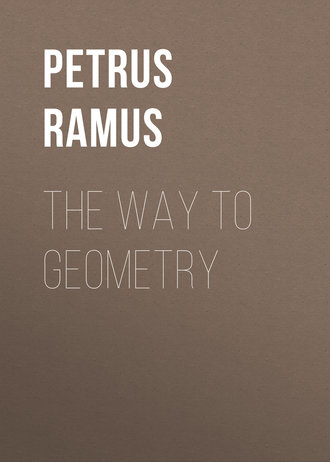 полная версия
полная версияThe Way To Geometry
2. A Right angle is a parallelogramme that hath all his angles right angles.
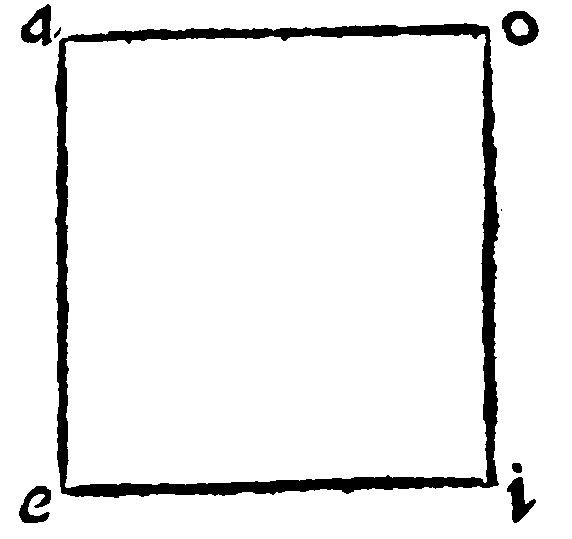
As in aeio. And here hence you must understand by one right angle that all are right angles. For the right angle at a, is equall to the opposite angle at i, by the 10 e x.
And therefore they are both right angles, by the 14 e iij. The other angle at e, and o, by the 4 e vj, are equall to two right angles: And they are equall betweene themselves, by the 10 e x. Therefore all of them are right angles. Neither may it indeed possible be, that in a parallelogramme there should be one right angle, but by and by they must be all right angles.
Therefore
3 A rightangle is comprehended of two right lines comprehending the right angle 1. d ij.
Comprehension, in this place doth signifie a certaine kind of Geometricall multiplication. For as of two numbers multiplied betweene themselves there is made a number: so of two sides (ductis) driven together, a right angle is made: And yet every right angle is not rationall, as before was manifest, at the 12. e iiij, and shall after appeare at the 9 e.
And
4 Foure right angles doe fill a place.
Neither is it any matter at all whether the foure rectangles be equall, or unequall; equilaters, or unequilaters; homogeneals, or heterogenealls. For which way so ever they be turned, the angles shall be right angles: And therefore they shall fill a place.

5 If the diameter doe cut the side of a right angle into two aquall parts, it doth cut it perpendicularly: And contrariwise.
As here appeareth by the 1 e vij. by drawing of the diagonies of the bisegments. The converse is manifest, by the 2 e vij. and 17. e vij.
Therefore
6 If an inscribed right line doe perpendicularly cut the side of the right angle into two equall parts, it is the diameter.
The reason is, because it doth cut the parallelogramme into two equall portions.
7 A right angle is equall to the rightangles made of one of his sides and the segments of the other.
As here the foure particular right angles are equall to the whole, which are made of ae, one of his sides, and of ei, io, ou, uy, the segments of the other.
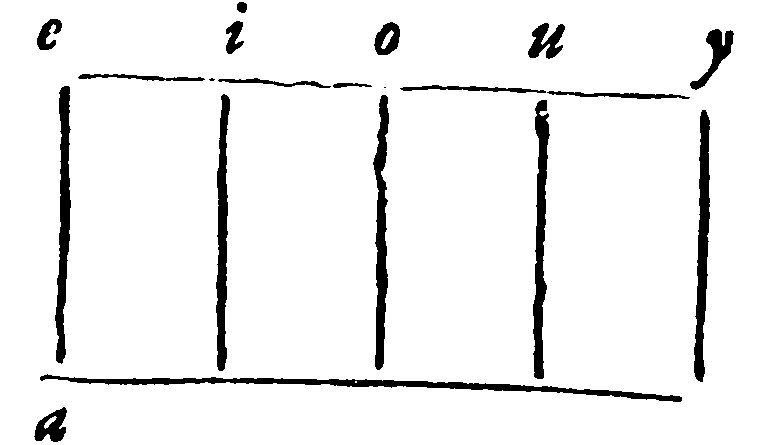
The Demonstration of this is from the rule of congruency: Because the whole agreeth to all his parts. But the same reason in numbers is more apparent by an induction of the parts: as foure times eight are 32. I breake or divide 8. into 5. and 3. Now foure times 5. are 20. And foure times 3. are 12. And 20. and 12. are 32. And 32. and 32. are equall. Therefore 20. and 12. are also equall to 32.
Lastly, every arithmeticall multiplication of the whole numbers doth make the same product, that the multiplication of the one of the whole numbers given, by the parts of the other shall make: yea, that the multiplication of the parts by the parts shall make. This proportion is cited by Ptolomey in the 9. Chapter of the 1 booke of his Almagest.
8 If foure right lines be proportionall, the rectangle of the two middle ones, is equall to the rectangle of the two extremes. 16. p vj.

It is a speciall consectary out of the 28 e x. As here are foure right lines proportionall betweene themselves: And the rectangle of the extremes, or first and last let it be ay: Of the middle ones, let it be se.
9 The figurate of a rationall rectangle is called a rectinall plaine. 16. d vij.
A rationall figure was defined at the 12. e iiij. of which sort amongst all the rectilineals hitherto spoken of, we have not had one: The first is a Right angled parallelogramme; And yet not every one indifferently: But that onely whose base is rationall to the highest: And that reason of the base and heighth is expressable by a number, where also the Figurate is defined. A rectangle or irrational sides, such as were mentioned at the 9 e j. is irrationall. Therefore a rectangled rationall of rationall sides, is here understood: And the figurate thereof, is called, by the generall name, A Plaine: Because of all the kindes of Plaines, this kinde onely is rationall.
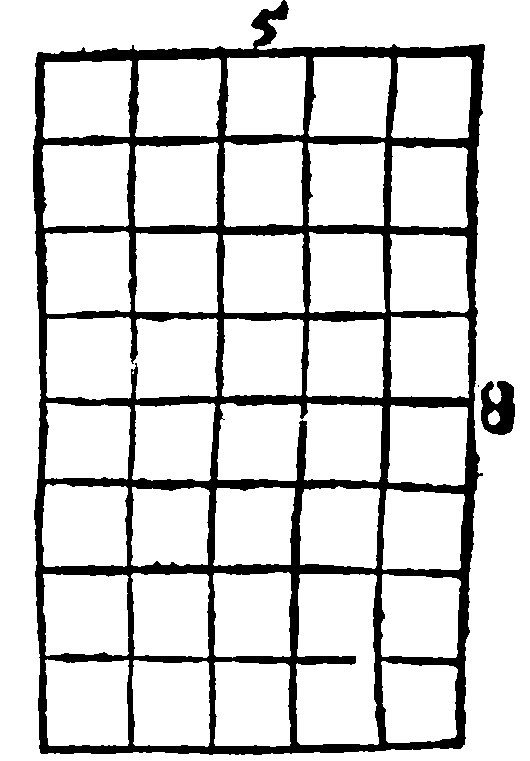

If therefore the Base of a Rectangle be 6. And the height 4. The plot or content shall be 24. And if it be certaine that the rectangles content be 24. And the base be 6. It shall also be certaine that the heighth is 4. The example is thus.
And this multiplication, as appeared at the 13. e iiij. is geometricall: As if thou dost multiply 5. by 8. thou makest 40. for the Plaine: And the sides of this Plaine, are 5. and 8. it is all one as if thou hadst made a rectangled parallellogramme of 40. square foote content, whose base should be 5. foote, and the heigth 8. after this manner.
This manner of multiplication, say I, is Geometricall: Neither are there here, of lines made lines, as there of unities were made unities; but a magnitude one degree higher, to wit, a surface, is here made.
Here hence is the Geodesy or manner of measuring of a rectangled triangle made knowne unto us. For when thou shalt multiply the shankes of a right angle, the one by the other, thou dost make the whole rectangled parallelogramme, whose halfe is a triangle, by the 12. e x.
Of Geometry the twelfth Booke, Of a Quadrate
1 A Rectangle is a Quadrate or an Oblong.
This division is made in the proper termes: but the thing it selfe and the subject difference is common out of the angles and sides.
2 A Quadrate is a rectangle equilater 30. d j.
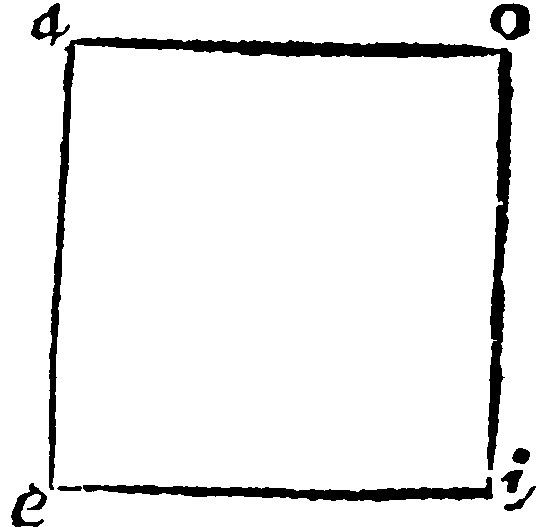
Quadratum, a Quadrate, or square, is a rectangled parallellogramme of equall sides: as here thou seest aeio, to be.
Plaines are with us, according to their diverse natures and qualities, measured with divers and sundry kindes of measures. Boord, Glasse, and Paving-stone are measured by the foote: Cloth, Wainscote, Painting, Paving, and such like, by the yard: Land, and Wood, by the Perch or Rodde.
Of Measures and sundry sorts thereof commonly used and mentioned in histories we have in the former spoken at large: Yet for the farther confirmation of some thing then spoken, and here againe now upon this particular occasion repeated, it shall not be amisse to heare what our Statutes speake of these three sorts here mentioned.
It is ordained, saith the Statute, That three Barley-cornes dry and round, doe make an Ynch: twelve ynches doe make a Foote: three foote doe make a Yard: Five yards and an halfe doe make a Perch: Fortie perches in length, and foure in breadth doe make an Aker. 33. Edwardi 1. De Terris mensurandis. Item, De compositione Ulnarum & Perticarum.
Moreover observe, that all those measures there spoken of were onely lengths: These here now last repeated, are such as the magnitudes by them measured are, in Planimetry, I meane, they are Plaines: In Stereometry they are solids, as hereafter we shall make manifest. Therefore in that which followeth, An ynch is not onely a length three barley-cornes long: but a plaine three barley-cornes long, and three broad. A Foote is not onely a length of 12. ynches: But a plaine also of 12. ynches square, or containing 144. square ynches: A yard is not onely the length of three foote: But it is also a plaine 3. foote square every way. A Perch is not onely a length of 5½. yards: But it is a plot of ground 5½. yards square every way.
A Quadrate therefore or square, seeing that it is equilater that is of equall sides: And equiangle by meanes of the equall right angles, of quadrangles that onely is ordinate.
Therefore
3 The sides of equall quadrates, are equall.
And
The sides of equall quadrates are equally compared: If therefore two or more quadrates be equall, it must needs follow that their sides are equall one to another.
And
4 The power of a right line is a quadrate.
Or thus: The possibility of a right line is a square H. A right line is said posse quadratum, to be in power a square; because being multiplied in it selfe, it doth make a square.
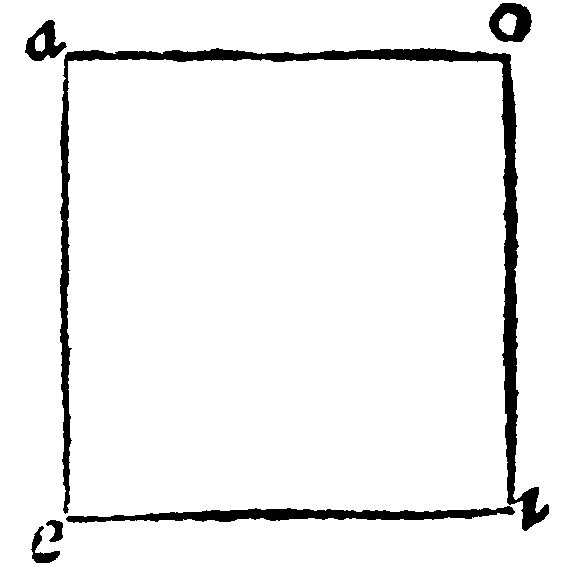
5 If two conterminall perpendicular equall right lines be closed with parallells, they shall make a quadrate. 46. p. j.
Or thus: If two equall perpendicular lines, ioyning one with another, be inclosed together by parallell lines they will make a square. H. As in aeio, let the perpendiculars ae, and ei, equall betweene themselves, be closed with two parallells, ao, against ei: And oi, against ae; they shall make the quadrate or square aeio. For it is a parallelogramme, by the grant: Because the opposite sides are parallell: And it is rectangled: because seeing the angle aei, of the perpendicular lines, is a right angle, they shall be all right angles by the 2 e xj. Then one side ei, is equall to all the rest. First to ao, that over against it, by the 8 e x. And then to ea, by the grant: And therefore to oi, to that over against it, by the 8 e x.
6 The plaine of a quadrate is an equilater plaine.
Or thus: The plaine number of a square, is a plaine number of equall sides, H.
A quadrate or square number, is that which is equally equall: Or that which is comprehended of two equall numbers, A quadrate of all plaines is especially rationall; and yet not alwayes: But that onely is rationall whose number is a quadrate. Therefore the quadrates of numbers not quadrates, are not rationalls.
Therefore
7 A quadrate is made of a number multiplied by it self.
Such quadrates are the first nine. 1, 4, 9, 16, 25, 36, 49, 64, 81, made of once one, twice two, thrise three, foure times foure, five times five, sixe times sixe, seven times seven, eight times eight, and nine times nine. And this is the summe of the making and invention of a quadrate number of multiplication of the side given by it selfe.

Hereafter diverse comparisons of a quadrate or square, with a rectangle, with a quadrate, and with a rectangle and a quadrate iointly. The comparison or rate of a quadrate with a rectangle is first.
And
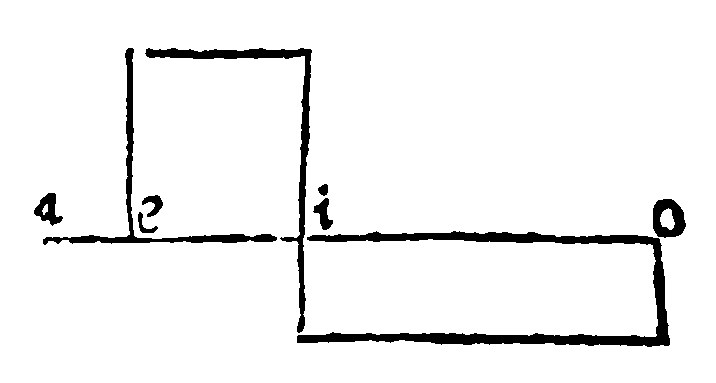
8 If three right lines be proportionall, the quadrate of the middle one, shall be equall to the rectangle of the extremes: And contrariwise: 17. p vj. and 20. p vij.
Or thus: If three lines be proportionall, the square made of the middle line is equall to the right angled parallelogramme made of the two outmost lines: H.
It is a corallary out of the 28. e x. As in ae, ei, io.
9 If the base of a triangle doe subtend a right angle, the powre of it is as much as of both the shankes: And contrariwise 47, 48. p j.
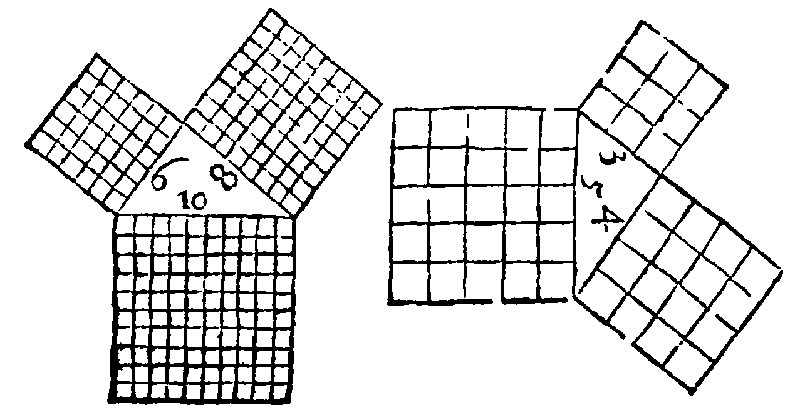
It is a consectary out of the 11. e viij. But it is sometime rationall, and to be expressed by a number: yet but in a scalene triangle onely. For the sides of an equicrurall right-angled triangle are irrationall; Whereas the sides of a scalene are sometime rationall; and that after two manners, the one of Pythagoras, the other of Plato, as Proclus teacheth, at the 47. p j. Pythagora's way is thus, by an odde number.

10 If the quadrate of an odde number, given for the first shanke, be made lesse by an unity; the halfe of the remainder shall be the other shanke; increased by an unity it shall be the base.
Or thus: If the square of an odde number given for the first foote, have an unity taken from it, the halfe of the remainder shall be the other foote, and the same halfe increased by an unitie, shall be the base: H.
As in the example: The sides are 3, 4, and 5. And 25. the square of 5. the base, is equall to 16. and 9. the squares of the shanks 4. and 3.
Againe, the quadrate or square of 3. the first shanke is 9. and 9 – 1. is 8, whose halfe 4, is the other shanke. And 9 + 1, is 10. whose halfe 5. is the base. Plato's way is thus by an even number.
11 If the halfe of an even number given for the first shanke be squared, the square number diminished by an unity shall be the other shanke, and increased by an unitie it shall be the base.
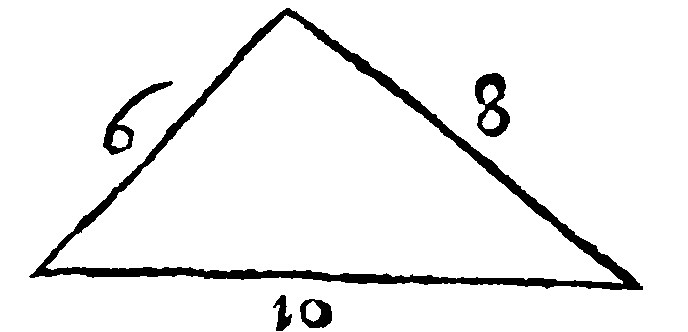
As in this example where the sides are 6, 8. and 10. For 100. the square of 10. the base is equall to 36. and 64. the squares of the shankes 6. and 8.
Againe, the quadrate or square of 3. the halfe of 6, the first shanke, is 9. and 9 – 1, is 8, for the second shanke. And out of this rate of rationall powers (as Vitruvius, in the 2. Chapter of his IX. booke) saith Pythagoras taught how to make a most exact and true squire, by joyning of three rulers together in the forme of a triangle, which are one unto another as 3, 4. and 5. are one to another.
From hence Architecture learned an Arithmeticall proportion in the parts of ladders and stayres. For that rate or proportion, as in many businesses and measures is very commodious; so also in buildings, and making of ladders or staires, that they may have moderate rises of the steps, it is very speedy. For 9 + 1. is, 10, base.
12. The power of the diagony is twise asmuch, as is the power of the side, and it is unto it also incommensurable.
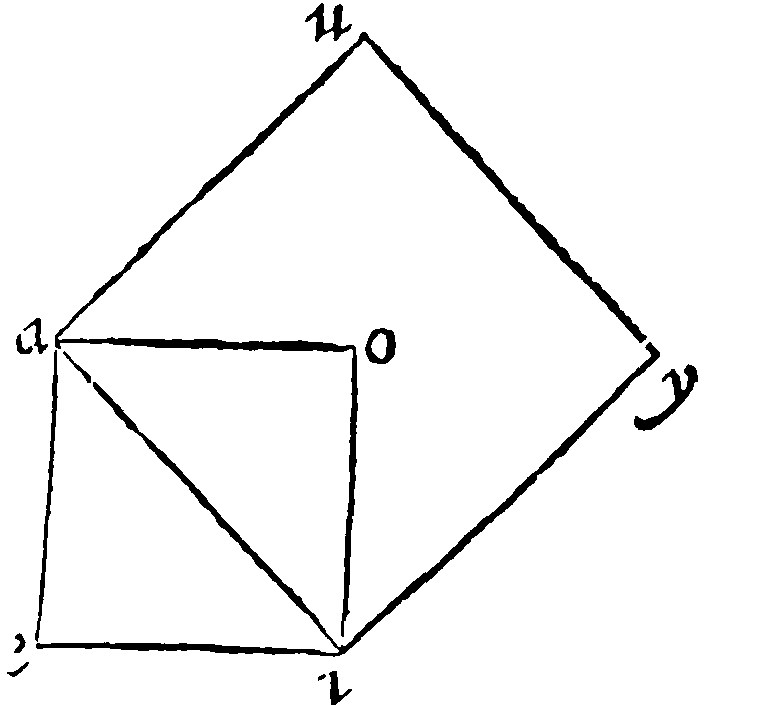
Or thus: The diagonall line is in power double to the side, and is incommensurable unto it, H.
As here thou seest, let the first quadrate bee aeio: Of whose diagony ai, let there be made the quadrate aiuy: This, I say, shall be the double of that: seeing that the diagonies power is equall to the power of both the equall shankes. Therefore it is double to the power of one of them.
This is the way of doubling of a square taught by Plato, as Vitruvius telleth us: Which notwithstanding may be also doubled, trebled, or according to any reason assigned increased, by the 25 e iiij, as there was foretold.
But that the Diagony is incommensurable unto the side it is the 116 p x. The reason is, because otherwise there might be given one quadrate number, double to another quadrate number: Which as Theon and Campanus teach us, is impossible to be found. But that reason which Aristotle bringeth is more cleare which is this; Because otherwise an even number should be odde. For if the Diagony be 4, and the side 3: The square of the Diagony 16, shall be double to the square of the side: And so the square of the side shall be 8. and the same square shall be 9, to wit, the square of 3. And so even shall be odde, which is most absurd.
Hither may be added that at the 42 p x. That the segments of a right line diversly cut; the more unequall they are the greater is their power.
13. If the base of a right angled triangle be cut by a perpendicular from the right angle in a doubled reason, the power of it shall be halfe as much more, as is the power of the greater shanke: But thrise so much as is the power of the lesser. If in a quadrupled reason, it shall be foure times and one fourth so much as is the greater: But five times so much as is the lesser, At the 13, 15, 16 p xiij.
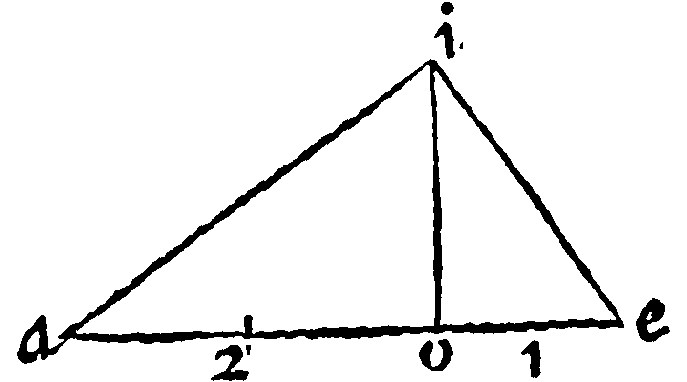
Or thus: If the base of a right angled triangle be cut in double proportion, by a perpendicular comming from the right angle, it is in power sesquialter to the greater foote; and treble to the lesser: But if the base be cut in quadruple proportion, it is sesquiarta to the greater side, and quintuple to the lesser.
As in aei, let the base ae, be so cut that the segment ao, be double to the segment oe, to wit, as 2 is to 1. The whole ae, shall be unto ao sesquialtera, that is, as 2 is to 3. And therefore by the 10 e viij, and 25 e iiij, the square of ae, shall be sesquialterum unto the square of ai.

And by the same argument it shall be treble unto the quadrate or square of ei.
The other, of the fourefold or quadruple section, are manifest in the figure following, by the like argument.
14 If a right line be cut into how many parts so ever, the power of it is manifold unto the power of segment, denominated of the square of the number of the section.
Or thus: if a right line be cut into how many parts soever it is in power the multiplex of the segment, the square of the number of the section, being denominated thereof: H.

So if it be cut into two equall parts, the power of it shall be foure times so much, as is the power of the halfe, taking demonstration from 4, which is the square of 2, according to which the division was made: If it be cut into three equall parts, the power of it shall be nine fold the power of the third part. If into foure equall parts, it shall be 16 times so much as is the power of the quarter: As here thou seest in these examples.
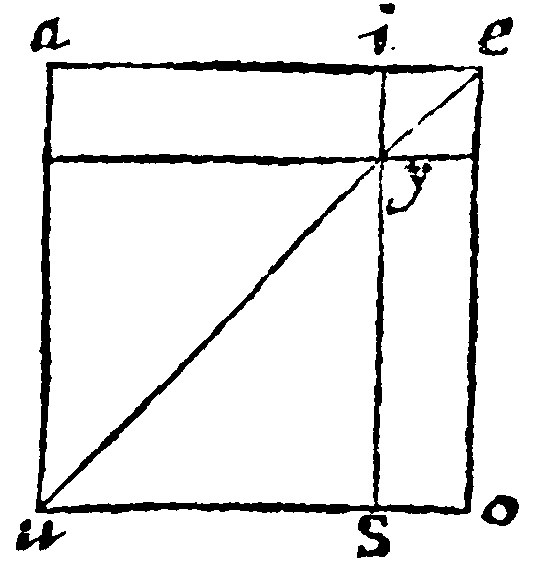
15. If a right line be cut into two segments, the quadrate of the whole is equall to the quadrats of the segments, and a double rectanguled figure, made of them both. 4 p ij.
The third rate of a quadrate is hereafter with two rectangles, and two quadrates, and first of equality.
This is a consectary out of the 22 e x: Because a parallelogramme is equall to his two diagonals and complements. If the right ae, be cut in i, it maketh the quadrate aeuo, greater than eyi, and yus, the quadrates of the segments, by the two rectangles ay and yo. This is the rate of a quadrate with a rectangle and a quadrate. But the side of a quadrate proposed in a number is oft times sought. Therefore by the next precedent element and his consectaries, the analysis or finding of the side of a quadrate is made and taught.
Therefore
16. The side of the first diagonall, is the side of one of the complements; And being doubled, it is the side of them both together: Now the other side of the same complements both together, is the side of the other diagonall.
The side of a quadrate given is many times in numbers sought. Therefore by the former element and his consectaries the resolution of a quadrates side is framed and performed.
Let therefore the side now of the quadrate number given be sought: And first let the Genesis or making be considered, such as you see here by the multiplication of numbers in the numbers themselves:
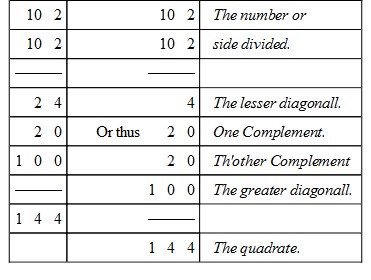
This is the rate of a quadrate with a rectangle & a quadrate, from whence is had the analisis or resolution of the side of a quadrate expressable by a number. For it is the same way fro Cambridge to London, that is from London to Cambridge. And this use of geometricall analysis remaineth, as afterward in a Cube, when as otherwise through the whole booke of Euclides Elements there is no other use at all of that.
Here therefore thou shalt note or marke out the severall quadrates, beginning at the right hand and so proceeding towards the left; after this manner, 144. These notes doe signifie that so many severall sides to be found, to make up the whole side of the quadrate given. And here first, it shall not be amisse to warne thee, before thou commest to practice, that for helpe of memory and speed in working, thou know the Quadrats of the nine single numbers of figures; which are these



Sometime after the quadrate now found, in the next places, there is neither any plaine nor square to bee found: Therefore the single side thereof shall be O. As in the quadrate 366025, the whole side is 605, consisting of three severall sides, of which the middle one is o.
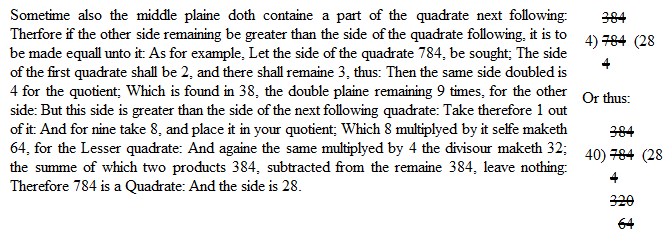
And from hence the invention of a meane proportionall, betweene two numbers given, (if there be any such to be found) is manifest. For if the product of two numbers given be a quadrate, the side of the quadrate shall be the meane proportionall, betweene the numbers given; as is apparent by the golden rule: As for example, Betweene 4. and 9. two numbers given, I desire to know what is the meane proportion. I multiply therefore 4 and 9. betweene themselves, and the product is 36: which is a quadrate number; as you see in the former; And the side is 6. Therefore I say, the meane proportionall betweene 4. and 9. is 6, that is, As 4. is to 6. so is 6. to 9.
If the number given be not a quadrate, there shall no arithmeticall side, and to be expressed by a number be found: And this figurate number is but the shadow of a Geometricall figure, and doth not indeede expresse it fully, neither is such a quadrate rationall: Yet notwithstanding the numerall side of the greatest square in such like number may be found: As in 148. The greatest quadrate continued is 144 and the side is 12. And there doe remaine 4. Therefore of such kinde of number, which is not a quadrate, there is no true or exact side: Neither shall there ever be found any so neare unto the true one; but there may still be one found more neare the truth. Therefore the side is not to be expressed by a number.
Of the invention of this there are two wayes: The one is by the Addition of the gnomon; The other is by the Reduction of the number assigned unto parts of some greater denomination. The first is thus:
17 If the side found be doubled, and to the double a unity be added, the whole shall be the gnomon of the next greater quadrate.
For the sides is one of the complements, and being doubled it is the side of both together. And an unity is the latter diagonall. So the side of 148 is 12.4/25.
The reason of this dependeth on the same proposition, from whence also the whole side, is found. For seeing that the side of every quadrate lesser than the next follower differeth onely from the side of the quadrate next above greater than it but by an 1. the same unity, both twice multiplied by the side of the former quadrate, and also once by it selfe, doth make the Gnomon of the greater to be added to the quadrate. For it doth make the quadrate 169. Whereby is understood, that looke how much the numerator 4. is short of the denominatour 25. so much is the quadrate 148. short of the next greater quadrate. For if thou doe adde 21. which is the difference whereby 4 is short of 25. thou shalt make the quadrate 169. whose side is 13. The second is by the reduction, as I said, of the number given unto parts assigned of some great denomination, as 100. or 1000. or some smaller than those, and those quadrates, that their true and certaine may be knowne: Now looke how much the smaller they are, so much nearer to the truth shall the side found be.



